One DODGE RAM 1500 1998 2.G Workshop Manual
[x] Cancel search | Manufacturer: DODGE, Model Year: 1998, Model line: RAM 1500, Model: DODGE RAM 1500 1998 2.GPages: 2627
Page 1742 of 2627
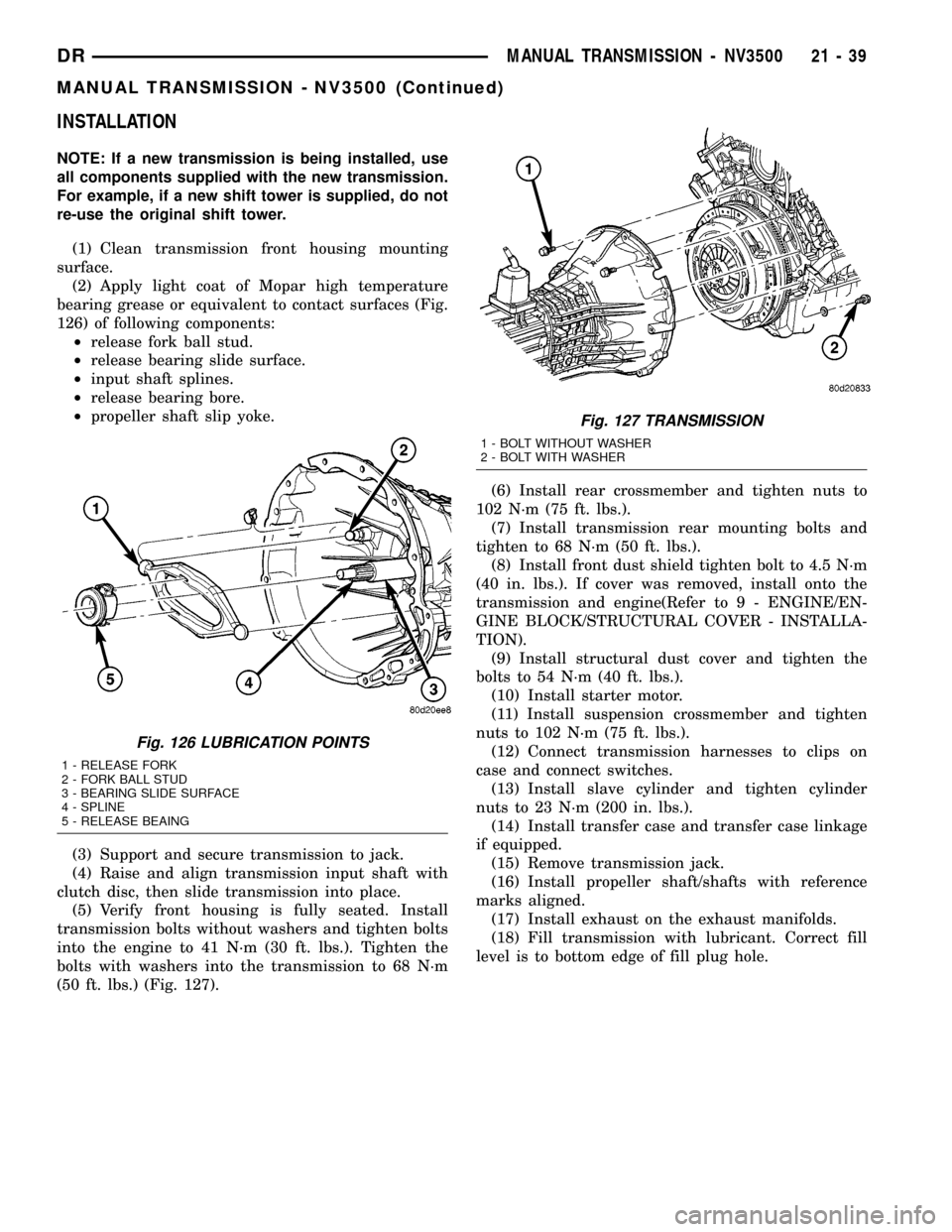
INSTALLATION
NOTE: If a new transmission is being installed, use
all components supplied with the new transmission.
For example, if a new shift tower is supplied, do not
re-use the original shift tower.
(1) Clean transmission front housing mounting
surface.
(2) Apply light coat of Mopar high temperature
bearing grease or equivalent to contact surfaces (Fig.
126) of following components:
²release fork ball stud.
²release bearing slide surface.
²input shaft splines.
²release bearing bore.
²propeller shaft slip yoke.
(3) Support and secure transmission to jack.
(4) Raise and align transmission input shaft with
clutch disc, then slide transmission into place.
(5) Verify front housing is fully seated. Install
transmission bolts without washers and tighten bolts
into the engine to 41 N´m (30 ft. lbs.). Tighten the
bolts with washers into the transmission to 68 N´m
(50 ft. lbs.) (Fig. 127).(6) Install rear crossmember and tighten nuts to
102 N´m (75 ft. lbs.).
(7) Install transmission rear mounting bolts and
tighten to 68 N´m (50 ft. lbs.).
(8) Install front dust shield tighten bolt to 4.5 N´m
(40 in. lbs.). If cover was removed, install onto the
transmission and engine(Refer to 9 - ENGINE/EN-
GINE BLOCK/STRUCTURAL COVER - INSTALLA-
TION).
(9) Install structural dust cover and tighten the
bolts to 54 N´m (40 ft. lbs.).
(10) Install starter motor.
(11) Install suspension crossmember and tighten
nuts to 102 N´m (75 ft. lbs.).
(12) Connect transmission harnesses to clips on
case and connect switches.
(13) Install slave cylinder and tighten cylinder
nuts to 23 N´m (200 in. lbs.).
(14) Install transfer case and transfer case linkage
if equipped.
(15) Remove transmission jack.
(16) Install propeller shaft/shafts with reference
marks aligned.
(17) Install exhaust on the exhaust manifolds.
(18) Fill transmission with lubricant. Correct fill
level is to bottom edge of fill plug hole.
Fig. 126 LUBRICATION POINTS
1 - RELEASE FORK
2 - FORK BALL STUD
3 - BEARING SLIDE SURFACE
4 - SPLINE
5 - RELEASE BEAING
Fig. 127 TRANSMISSION
1 - BOLT WITHOUT WASHER
2 - BOLT WITH WASHER
DRMANUAL TRANSMISSION - NV3500 21 - 39
MANUAL TRANSMISSION - NV3500 (Continued)
Page 1747 of 2627

The driver selects a particular gear by moving the
shift lever to the desired gear position. This move-
ment moves the internal transmission shift compo-
nents to begin the shift sequence. As the shift lever
moves the selected shift rail, the shift fork attached
to that rail begins to move. The fork is positioned in
a groove in the outer circumference of the synchro-
nizer sleeve. As the shift fork moves the synchronizer
sleeve, the synchronizer begins to speed-up or slow
down the selected gear (depending on whether the
driver is up-shifting or down-shifting). The synchro-
nizer does this by having the synchronizer hub
splined to the mainshaft, or the countershaft in some
cases, and moving the blocker ring into contact with
the gear's friction cone. As the blocker ring and fric-
tion cone come together, the gear speed is brought up
or down to the speed of the synchronizer. As the two
speeds match, the splines on the inside of the syn-
chronizer sleeve become aligned with the teeth on
the blocker ring and the friction cone and eventually
will slide over the teeth, locking the gear to the
mainshaft, or countershaft, through the synchronizer.
DIAGNOSIS AND TESTING
LOW LUBRICANT LEVEL
A low transmission lubricant level is generally the
result of a leak, inadequate lubricant fill or an incor-
rect lubricant level check. A correct lubricant level
check can only be made when the vehicle is level.
Also allow the lubricant to settle for a minute or so
before checking. These recommendations will ensure
an accurate check and avoid an underfill or overfill
condition. Always check the lubricant level after any
addition of fluid to avoid an incorrect lubricant level
condition.
Leaks can occur at the mating surfaces of the gear
case, adaptor or extension housing, or from the front/
rear seals. A suspected leak could also be the result
of an overfill condition. Leaks at the rear of the
extension or adapter housing will be from the hous-
ing oil seals. Leaks at component mating surfaces
will probably be the result of inadequate sealer, gaps
in the sealer, incorrect bolt tightening or use of a
non-recommended sealer. A leak at the front of the
transmission will be from either the front bearing
retainer or retainer seal. Lubricant may be seen drip-
ping from the clutch housing after extended opera-
tion. If the leak is severe, it may also contaminate
the clutch disc causing the disc to slip, grab and or
chatter.
HARD SHIFTING
Hard shifting is usually caused by a low lubricant
level, improper or contaminated lubricants. The con-
sequence of using non-recommended lubricants isnoise, excessive wear, internal bind and hard shift-
ing. Substantial lubricant leaks can result in gear,
shift rail, synchro, and bearing damage. If a leak
goes undetected for an extended period, the first indi-
cations of component damage are usually hard shift-
ing and noise.
Component damage, incorrect clutch adjustment or
damaged clutch pressure plate or disc are additional
probable causes of increased shift effort. Incorrect
adjustment or a worn/damaged pressure plate or disc
can cause incorrect release. If clutch problem is
advanced, gear clash during shifts can result. Worn
or damaged synchro rings can cause gear clash when
shifting into any forward gear. In some new or
rebuilt transmissions, new synchro rings may tend to
stick slightly causing hard or noisy shifts. In most
cases this condition will decline as the rings wear-in.
TRANSMISSION NOISE
Most manual transmissions make some noise dur-
ing normal operation. Rotating gears generate a mild
whine that is audible, but generally only at extreme
speeds. Severe highly audible transmission noise is
generally the initial indicator of a lubricant problem.
Insufficient, improper or contaminated lubricant
will promote rapid wear of gears, synchros, shift
rails, forks and bearings. The overheating caused by
a lubricant problem, can also lead to gear breakage.
REMOVAL
(1) Shift transmission into Neutral.
(2) Remove shift boot screws from floorpan and
slide boot upward on the shift lever.
(3) Remove shift lever extension from shift tower
and lever assembly.
(4) Remove shift tower bolts (Fig. 2).
Fig. 2 SHIFT TOWER
1 - SHIFT TOWER
2 - SHIFTER
3 - BOLTS
21 - 44 MANUAL TRANSMISSION - NV4500DR
MANUAL TRANSMISSION - NV4500 (Continued)
Page 1749 of 2627
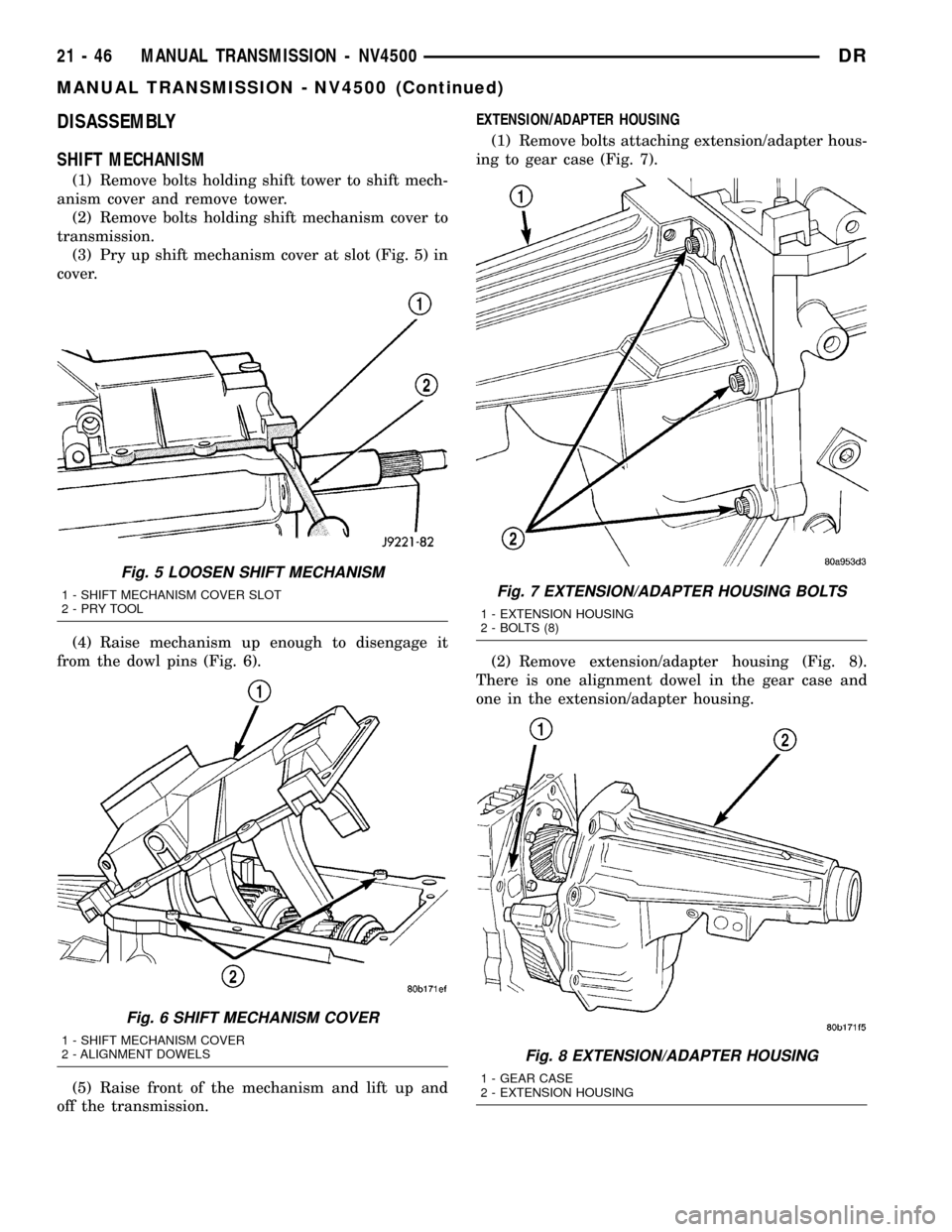
DISASSEMBLY
SHIFT MECHANISM
(1) Remove bolts holding shift tower to shift mech-
anism cover and remove tower.
(2) Remove bolts holding shift mechanism cover to
transmission.
(3) Pry up shift mechanism cover at slot (Fig. 5) in
cover.
(4) Raise mechanism up enough to disengage it
from the dowl pins (Fig. 6).
(5) Raise front of the mechanism and lift up and
off the transmission.EXTENSION/ADAPTER HOUSING
(1) Remove bolts attaching extension/adapter hous-
ing to gear case (Fig. 7).
(2) Remove extension/adapter housing (Fig. 8).
There is one alignment dowel in the gear case and
one in the extension/adapter housing.
Fig. 5 LOOSEN SHIFT MECHANISM
1 - SHIFT MECHANISM COVER SLOT
2-PRYTOOL
Fig. 6 SHIFT MECHANISM COVER
1 - SHIFT MECHANISM COVER
2 - ALIGNMENT DOWELS
Fig. 7 EXTENSION/ADAPTER HOUSING BOLTS
1 - EXTENSION HOUSING
2 - BOLTS (8)
Fig. 8 EXTENSION/ADAPTER HOUSING
1 - GEAR CASE
2 - EXTENSION HOUSING
21 - 46 MANUAL TRANSMISSION - NV4500DR
MANUAL TRANSMISSION - NV4500 (Continued)
Page 1750 of 2627
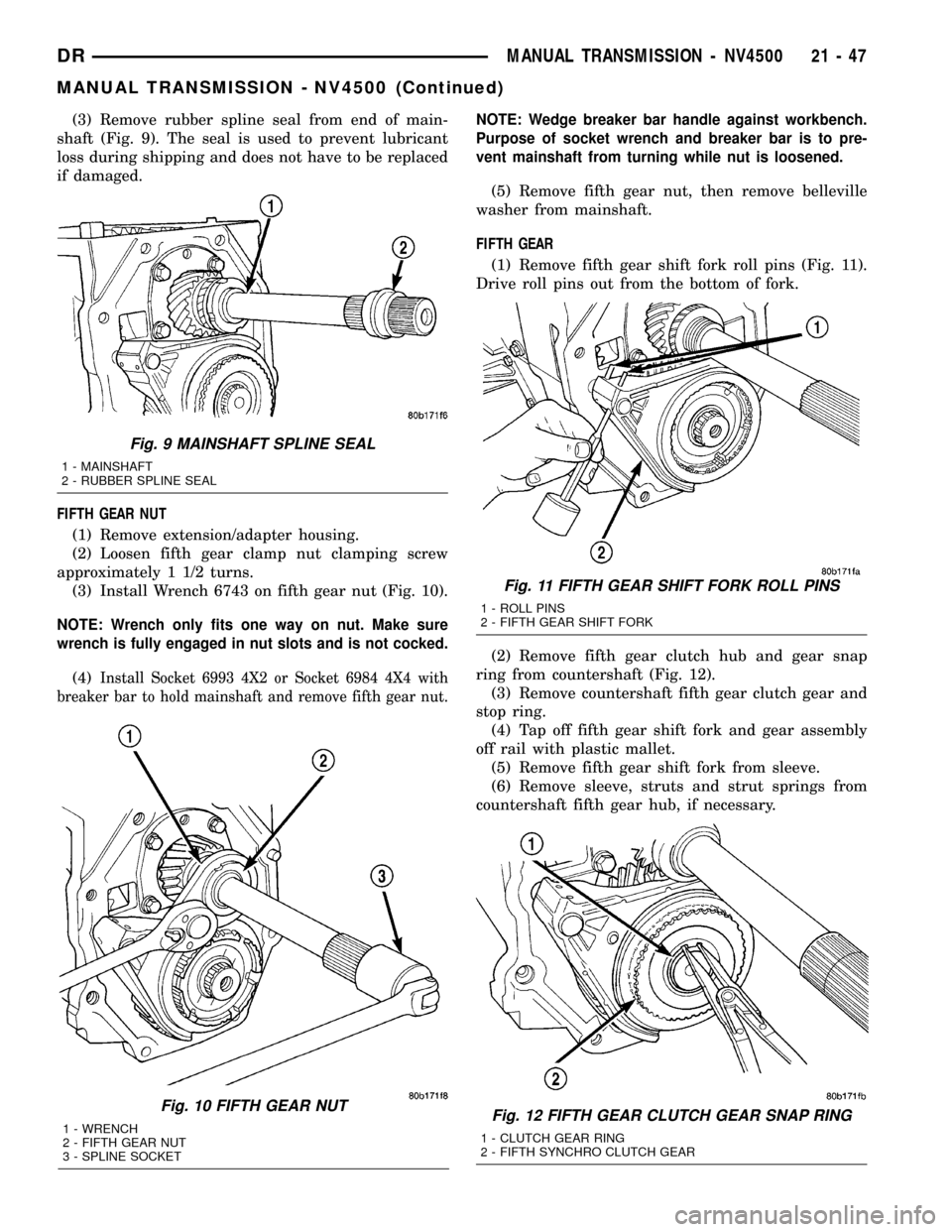
(3) Remove rubber spline seal from end of main-
shaft (Fig. 9). The seal is used to prevent lubricant
loss during shipping and does not have to be replaced
if damaged.
FIFTH GEAR NUT
(1) Remove extension/adapter housing.
(2) Loosen fifth gear clamp nut clamping screw
approximately 1 1/2 turns.
(3) Install Wrench 6743 on fifth gear nut (Fig. 10).
NOTE: Wrench only fits one way on nut. Make sure
wrench is fully engaged in nut slots and is not cocked.
(4)Install Socket 6993 4X2 or Socket 6984 4X4 with
breaker bar to hold mainshaft and remove fifth gear nut.
NOTE: Wedge breaker bar handle against workbench.
Purpose of socket wrench and breaker bar is to pre-
vent mainshaft from turning while nut is loosened.
(5) Remove fifth gear nut, then remove belleville
washer from mainshaft.
FIFTH GEAR
(1) Remove fifth gear shift fork roll pins (Fig. 11).
Drive roll pins out from the bottom of fork.
(2) Remove fifth gear clutch hub and gear snap
ring from countershaft (Fig. 12).
(3) Remove countershaft fifth gear clutch gear and
stop ring.
(4) Tap off fifth gear shift fork and gear assembly
off rail with plastic mallet.
(5) Remove fifth gear shift fork from sleeve.
(6) Remove sleeve, struts and strut springs from
countershaft fifth gear hub, if necessary.
Fig. 10 FIFTH GEAR NUT
1 - WRENCH
2 - FIFTH GEAR NUT
3 - SPLINE SOCKET
Fig. 9 MAINSHAFT SPLINE SEAL
1 - MAINSHAFT
2 - RUBBER SPLINE SEAL
Fig. 11 FIFTH GEAR SHIFT FORK ROLL PINS
1 - ROLL PINS
2 - FIFTH GEAR SHIFT FORK
Fig. 12 FIFTH GEAR CLUTCH GEAR SNAP RING
1 - CLUTCH GEAR RING
2 - FIFTH SYNCHRO CLUTCH GEAR
DRMANUAL TRANSMISSION - NV4500 21 - 47
MANUAL TRANSMISSION - NV4500 (Continued)
Page 1751 of 2627
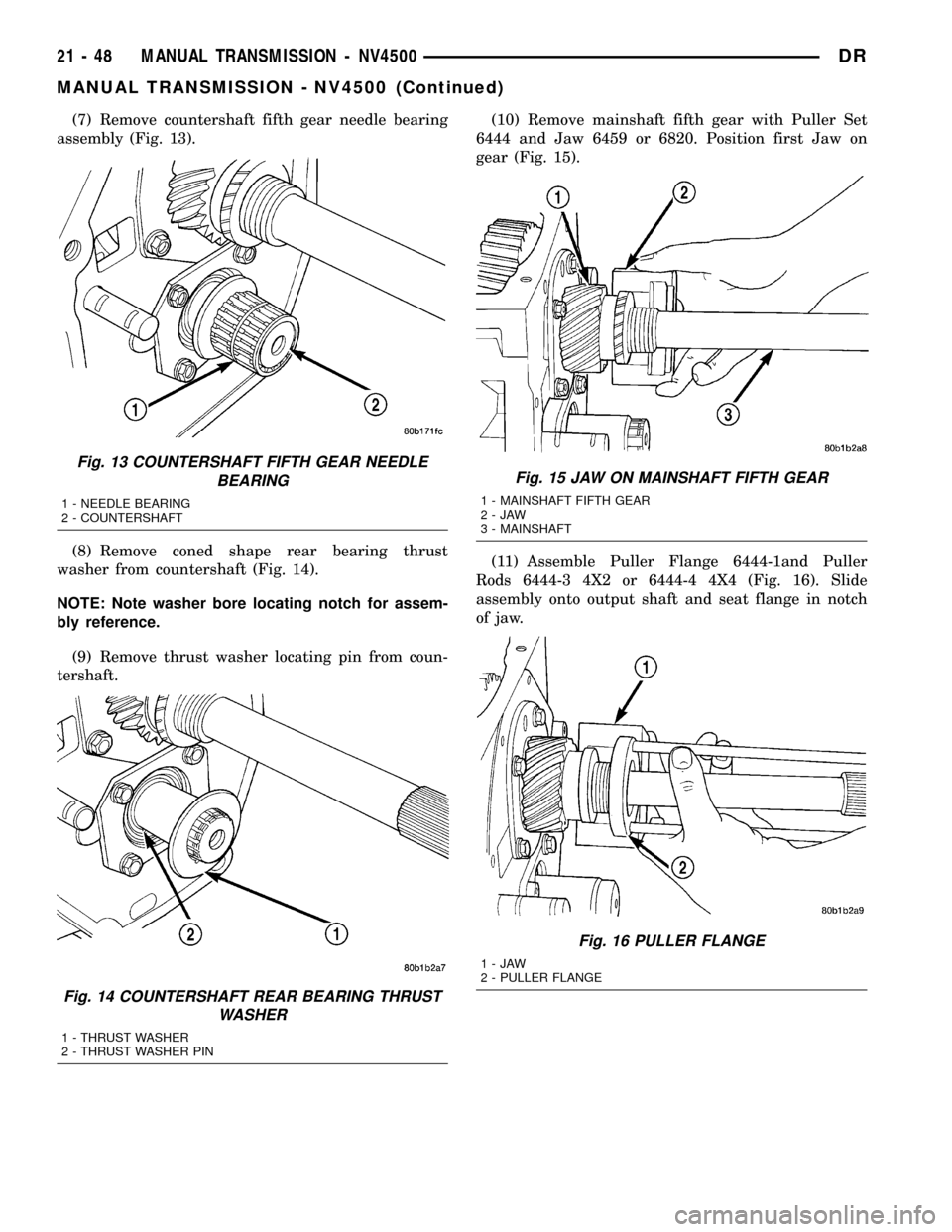
(7) Remove countershaft fifth gear needle bearing
assembly (Fig. 13).
(8) Remove coned shape rear bearing thrust
washer from countershaft (Fig. 14).
NOTE: Note washer bore locating notch for assem-
bly reference.
(9) Remove thrust washer locating pin from coun-
tershaft.(10) Remove mainshaft fifth gear with Puller Set
6444 and Jaw 6459 or 6820. Position first Jaw on
gear (Fig. 15).
(11) Assemble Puller Flange 6444-1and Puller
Rods 6444-3 4X2 or 6444-4 4X4 (Fig. 16). Slide
assembly onto output shaft and seat flange in notch
of jaw.
Fig. 13 COUNTERSHAFT FIFTH GEAR NEEDLE
BEARING
1 - NEEDLE BEARING
2 - COUNTERSHAFT
Fig. 14 COUNTERSHAFT REAR BEARING THRUST
WASHER
1 - THRUST WASHER
2 - THRUST WASHER PIN
Fig. 15 JAW ON MAINSHAFT FIFTH GEAR
1 - MAINSHAFT FIFTH GEAR
2-JAW
3 - MAINSHAFT
Fig. 16 PULLER FLANGE
1-JAW
2 - PULLER FLANGE
21 - 48 MANUAL TRANSMISSION - NV4500DR
MANUAL TRANSMISSION - NV4500 (Continued)
Page 1753 of 2627

(3) Remove front retainer seal by (Fig. 21) collaps-
ing one side of seal then prying it out.
(4) Remove front retainer bearing cup with Puller
6444. Assemble Puller Flange 6444-1 and Puller Rods
6444-4 (Fig. 22). Insert Jaws 6453-1 in puller flange.
Narrow lip of puller jaws will go under bearing cup.
(5) Install Disc C-4487-1 into bearing retainer for
Insert 6453-2 to rest upon.(6) Install assembled tools in front retainer (Fig.
23) with puller jaws seated under bearing cup. Place
Insert 6453-2 in center of puller jaws, to hold puller
jaws in place.
(7) Install Puller 6444 on puller rods (Fig. 24) and
install retaining nuts on puller rods. Tighten puller
bolt to draw bearing cup out of retainer.
Fig. 21 BEARING RETAINER SEAL
1 - SEAL
2 - FRONT BEARING RETAINER
Fig. 22 PULLER RODS, FLANGE AND JAWS
1 - RODS
2 - FLANGE
3-JAWS
Fig. 23 INSERT AND RETAINER
1 - INSERT
2 - FRONT RETAINER
3-JAWS
Fig. 24 BEARING CUP PULLER ASSEMBLY
1 - WRENCH
2 - INSERT
3 - FRONT RETAINER
4 - PULLER
5 - WRENCH
21 - 50 MANUAL TRANSMISSION - NV4500DR
MANUAL TRANSMISSION - NV4500 (Continued)
Page 1754 of 2627

DRIVE GEAR
(1) Remove drive gear (Fig. 25).
(2) Remove pilot bearing from drive gear (Fig. 26).(3) Remove tapered bearing from drive gear with
Puller Flange 6444-1 and Puller Rods 6444-6 (Fig.
27).
(4) Position first Jaw 6447 on bearing. Slide
assembled puller flange and rod tools onto input
shaft. Then seat flange in notch of puller jaw.
(5) Position second Jaw 6447 on gear and in notch
of puller flange. Slide Collar 6444-8 over puller jaws
to hold them in place.
(6) Install Puller 6444 on puller rods then install
retaining nuts. Tighten puller bolt to remove bearing
cone from drive gear.
Fig. 25 DRIVE GEAR
1 - MAINSHAFT
2 - DRIVE GEAR
Fig. 26 PILOT BEARING
1 - DRIVE GEAR
2 - MAINSHAFT PILOT BEARING
Fig. 27 FRONT BEARING PULLER
1 - PULLER
2 - RODS
3-JAWS
4 - COLLAR
5 - FLANGE
6 - DRIVE GEAR
DRMANUAL TRANSMISSION - NV4500 21 - 51
MANUAL TRANSMISSION - NV4500 (Continued)
Page 1756 of 2627
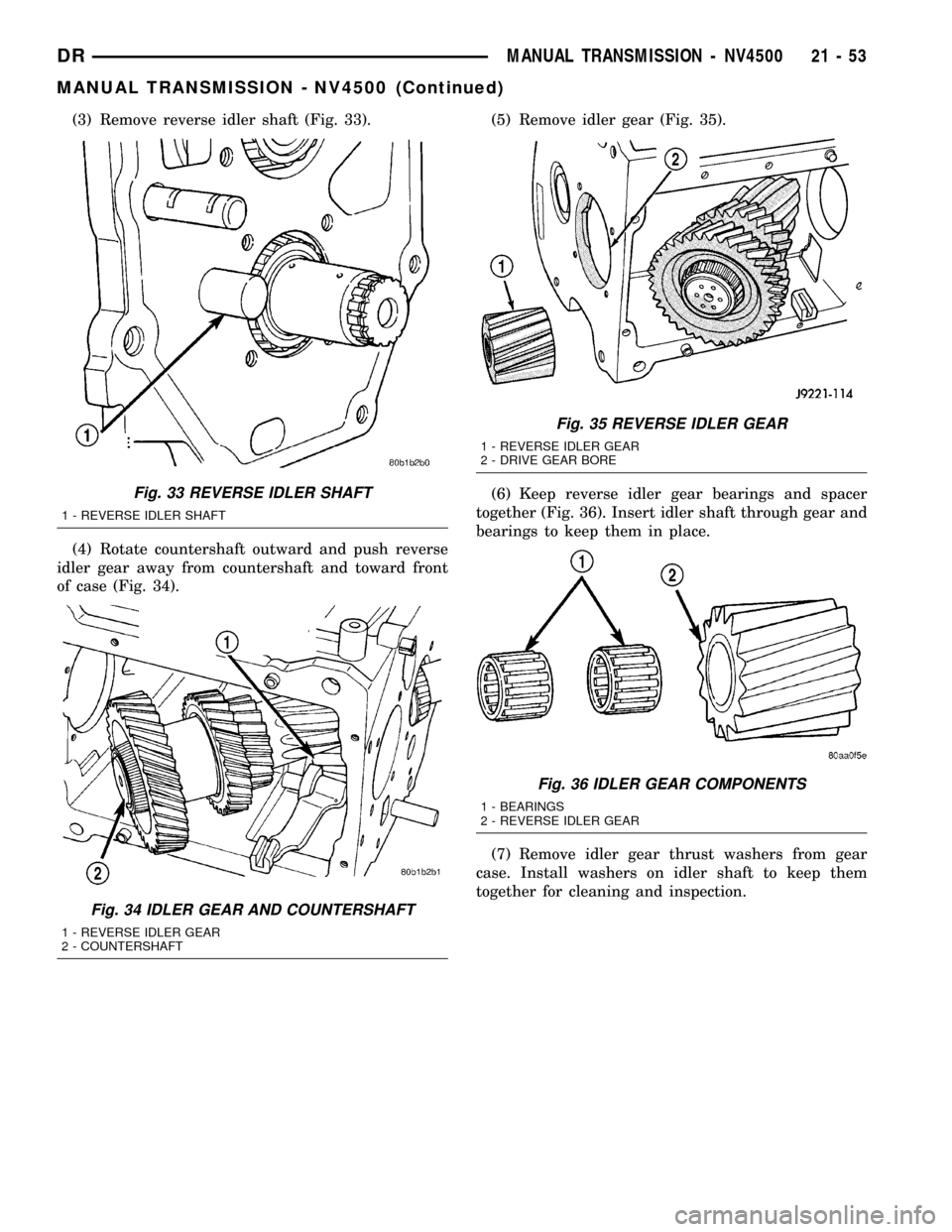
(3) Remove reverse idler shaft (Fig. 33).
(4) Rotate countershaft outward and push reverse
idler gear away from countershaft and toward front
of case (Fig. 34).(5) Remove idler gear (Fig. 35).
(6) Keep reverse idler gear bearings and spacer
together (Fig. 36). Insert idler shaft through gear and
bearings to keep them in place.
(7) Remove idler gear thrust washers from gear
case. Install washers on idler shaft to keep them
together for cleaning and inspection.
Fig. 33 REVERSE IDLER SHAFT
1 - REVERSE IDLER SHAFT
Fig. 34 IDLER GEAR AND COUNTERSHAFT
1 - REVERSE IDLER GEAR
2 - COUNTERSHAFT
Fig. 35 REVERSE IDLER GEAR
1 - REVERSE IDLER GEAR
2 - DRIVE GEAR BORE
Fig. 36 IDLER GEAR COMPONENTS
1 - BEARINGS
2 - REVERSE IDLER GEAR
DRMANUAL TRANSMISSION - NV4500 21 - 53
MANUAL TRANSMISSION - NV4500 (Continued)
Page 1757 of 2627
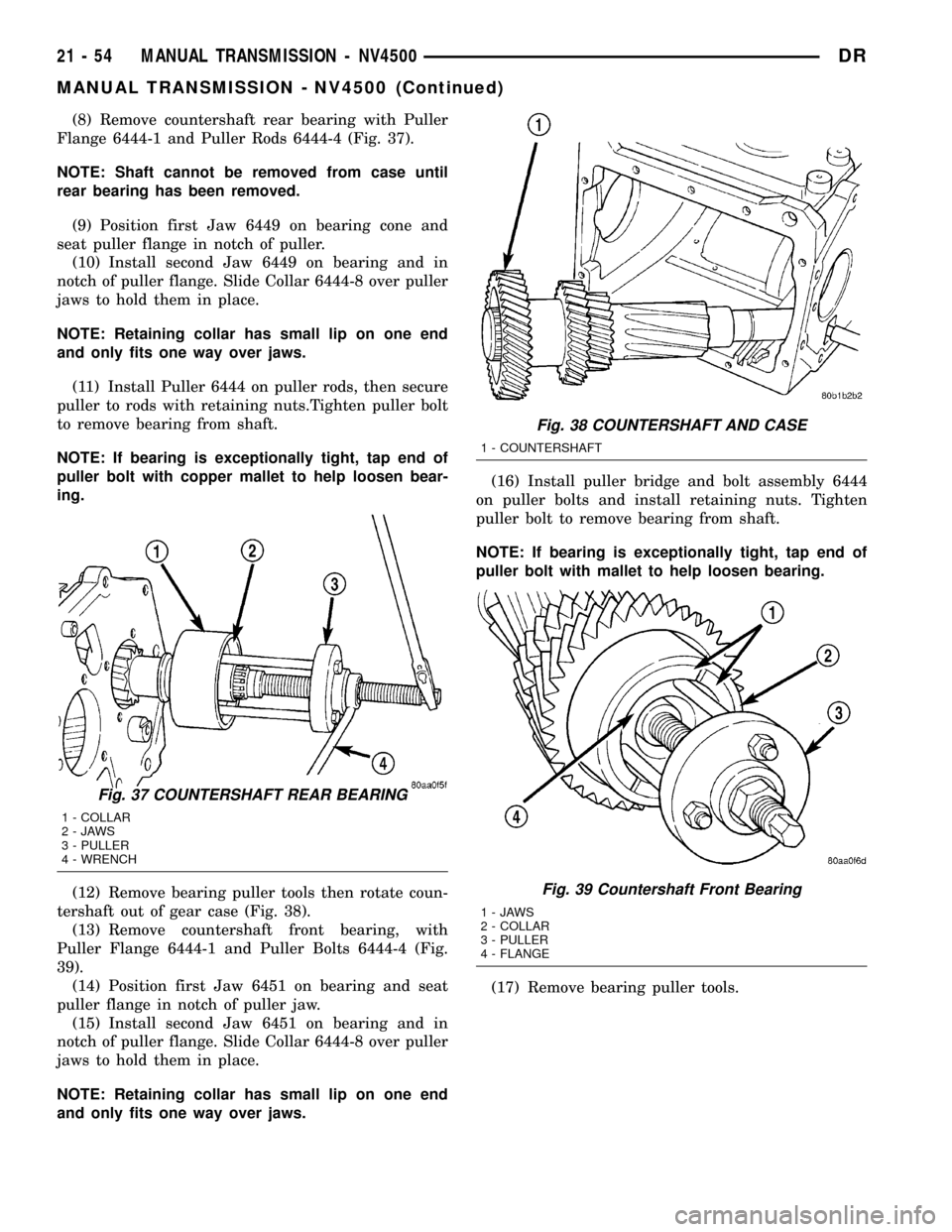
(8) Remove countershaft rear bearing with Puller
Flange 6444-1 and Puller Rods 6444-4 (Fig. 37).
NOTE: Shaft cannot be removed from case until
rear bearing has been removed.
(9) Position first Jaw 6449 on bearing cone and
seat puller flange in notch of puller.
(10) Install second Jaw 6449 on bearing and in
notch of puller flange. Slide Collar 6444-8 over puller
jaws to hold them in place.
NOTE: Retaining collar has small lip on one end
and only fits one way over jaws.
(11) Install Puller 6444 on puller rods, then secure
puller to rods with retaining nuts.Tighten puller bolt
to remove bearing from shaft.
NOTE: If bearing is exceptionally tight, tap end of
puller bolt with copper mallet to help loosen bear-
ing.
(12) Remove bearing puller tools then rotate coun-
tershaft out of gear case (Fig. 38).
(13) Remove countershaft front bearing, with
Puller Flange 6444-1 and Puller Bolts 6444-4 (Fig.
39).
(14) Position first Jaw 6451 on bearing and seat
puller flange in notch of puller jaw.
(15) Install second Jaw 6451 on bearing and in
notch of puller flange. Slide Collar 6444-8 over puller
jaws to hold them in place.
NOTE: Retaining collar has small lip on one end
and only fits one way over jaws.(16) Install puller bridge and bolt assembly 6444
on puller bolts and install retaining nuts. Tighten
puller bolt to remove bearing from shaft.
NOTE: If bearing is exceptionally tight, tap end of
puller bolt with mallet to help loosen bearing.
(17) Remove bearing puller tools.
Fig. 37 COUNTERSHAFT REAR BEARING
1 - COLLAR
2-JAWS
3 - PULLER
4 - WRENCH
Fig. 38 COUNTERSHAFT AND CASE
1 - COUNTERSHAFT
Fig. 39 Countershaft Front Bearing
1-JAWS
2 - COLLAR
3 - PULLER
4 - FLANGE
21 - 54 MANUAL TRANSMISSION - NV4500DR
MANUAL TRANSMISSION - NV4500 (Continued)
Page 1759 of 2627

MAINSHAFT
NOTE: Gear and synchro components can be
installed backwards. Paint or scribe gear and syn-
chro components for installation reference. Then
stack geartrain parts in order of removal.
(1) Remove drive gear thrust bearing from end of
mainshaft, if not previously removed.
(2) Place 3-4 gear in a press with support under
3rd gear and Remove 3-4 synchro hub, third gear
stop ring and third gear as an assembly (Fig. 43).
(3) Remove third gear bearing from mainshaft
(Fig. 44).
(4) Remove third gear bearing spacer (Fig. 45).
(5) Remove second gear thrust washer snap ring
from mainshaft (Fig. 45).
Fig. 43 THIRD GEAR, STOP RING, AND 3-4 HUB
1 - THIRD GEAR
2 - THIRD GEAR STOP RING
3 - 3-4 SYNCHRO HUB
Fig. 44 THIRD GEAR BEARING
1 - THIRD GEAR NEEDLE BEARING
Fig. 45 SNAP RING AND THIRD GEAR BEARING
SPACER
1 - SECOND GEAR THRUST WASHER
2 - THRUST WASHER SNAP RING
3 - THIRD GEAR BEARING SPACER
21 - 56 MANUAL TRANSMISSION - NV4500DR
MANUAL TRANSMISSION - NV4500 (Continued)